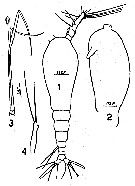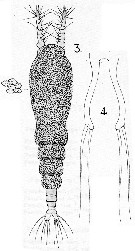|
|
 |
Fiche d'espèce de Copépode |
|
|
Monstrilloida ( Ordre ) |
|
|
|
Monstrillidae ( Famille ) |
|
|
|
Maemonstrilla ( Genre ) |
|
|
| |
Maemonstrilla longipes (A. Scott, 1909) (F) | |
| | | | | | | Syn.: | Monstrilla longipes A. Scott, 1909 (p.238, Descr.F, figs.F); Sewell, 1949 (p.141, Rem. F); Wickstead, 1961 (p.61, 62); Al-Kholy, 1963 (p.130, figs.F); Suarez-Morales, 1994 (p.264: Rem.); Grygier, 1995 a (p.70);
Non Monostrilla Longipes : Al-Kholy,1963 (p.130, figs.F) [see remarks in Grygier & Ohtsuka, 2008, p.492, synonyme probable] | | | | Ref.: | | | Grygier & Ohtsuka, 2008 (p.492, Rem.: comb. nov.).
Type locality: 0°24' S, 127°36' E |  issued from : A.A. Al-Kholy in Publs mar. biol. Stn Ghardaqa, 1963, 12. [p.131, Figs.1-4]. As Monostrilla longipes. Very doubtful at the specific level, presumably do belong to the M. hyottoko species-Group. Female (from Al-Ghardaqa, Red Sea): 1, habitus (dorsal); 2, cephalothorax (lateral); 3, genital spines; 4, P5.
|
 Issued from : A. Scott in The Copepoda of the Siboga Expedition Part I. Siboga-Expeditie XXIX a., 1909. [Pl. LVIII, Figs.3-4]. As Monstrilla longipes. Female (from off Laiwui, N Ceeram Sea): 3, habitus (dorsal); 4, P5. Nota: - Cephalic segment much inflated just behind the frontal margin; it is considerably longer than the posterior part of the body. - Frontal margin wide and broadly rounded. - Exoskeleton of the cephalic and first three thoracic segments marked by fine reticulations that are beset with minute spines. - Abdomen 3-segmented. - Genital segment sub-quadrangular in outline; slightly contracted at the middle where it is traversed by a distinct suture; the distal ends provided with small points. The segment is one and two-third times longer than the combined length of the next two segments. Its length rather shorter than the united length of the next two segments and caudal rami. - The 2nd and 3rd segments sub-equal in length. The distal end of the 3rd segment is decidedly expanded. - Caudal rami 3 times longer than the anal segment, each ramus with 1 outer marginal seta and 5 apical setae; the middle apical seta shorter than the others. - A1 4-segmented and equal to two-fifths of the length of the cephalothorax. - P5 long and slender and without apical division; the apex with 2 moderately strong setae.
| | | | | NZ: | 1 + 2 douteuses | | |
|
Carte de distribution de Maemonstrilla longipes par zones géographiques
|
| | | | | | | Loc: | | | [ Red Sea, Nicobar Is. (Nankauri Harbour) ], Indonesia-Malaysia (N Ceram Sea: off Laiwui, coast of Orbi Major), [ Singapore Strait ]
[doubtful identification]
Type locality: 0°24' S, 127°36' E. (Holotype not found in the collection). | | | | N: | 3 | | | | Lg.: | | | (5) F: 1,85; [(662) F: 2,25; (728) F: 1,55]; {F: 1,85} | | | | Rem.: | According to Sewell (1949, p.141) the proportional lengths of the various segments of the body are: 581:91:79:67:49:61:24:12: 36 = 1000. Genital segment divided into two sub-equal lengths by a groove or joint.
According to Grygier & Ohtsuka (2008, p.492) the Scott's description is sufficient to recognize Monstrilla longipes as a member of the new genus Maemonstrilla on the basis of its body form, the spinulose-reticulate cuticle of the cephalothorax and free metasomal pedigers, and the form and setation of P5. A suture crosses the dorsum of the genital segment, as in most species of Maemonstrilla. The ovigerous spines were not described. It is possible that one of the newly described species of the M. hyottoko group descrbed by the authors (but not L. simplex) is synonymous with M. longipes, but this cannot be demostrated.
Records of supposed female Monstrilla longipes fom Nicobar Islands (Sewell, 1949) and the Singapore Strait (Wickstead, 1961) and record from Ghardaqa, Red Sea (Al-Kholy, 1963), must be considered unsubstantiated at the specific level, although the specimens invloved presumably do belong to the M. hyottoko species group. | | | Dernière mise à jour : 23/04/2020 | |
|
|
 Toute utilisation de ce site pour une publication sera mentionnée avec la référence suivante : Toute utilisation de ce site pour une publication sera mentionnée avec la référence suivante :
Razouls C., Desreumaux N., Kouwenberg J. et de Bovée F., 2005-2026. - Biodiversité des Copépodes planctoniques marins (morphologie, répartition géographique et données biologiques). Sorbonne Université, CNRS. Disponible sur http://copepodes.obs-banyuls.fr [Accédé le 19 janvier 2026] © copyright 2005-2026 Sorbonne Université, CNRS
|
|
 |
 |





